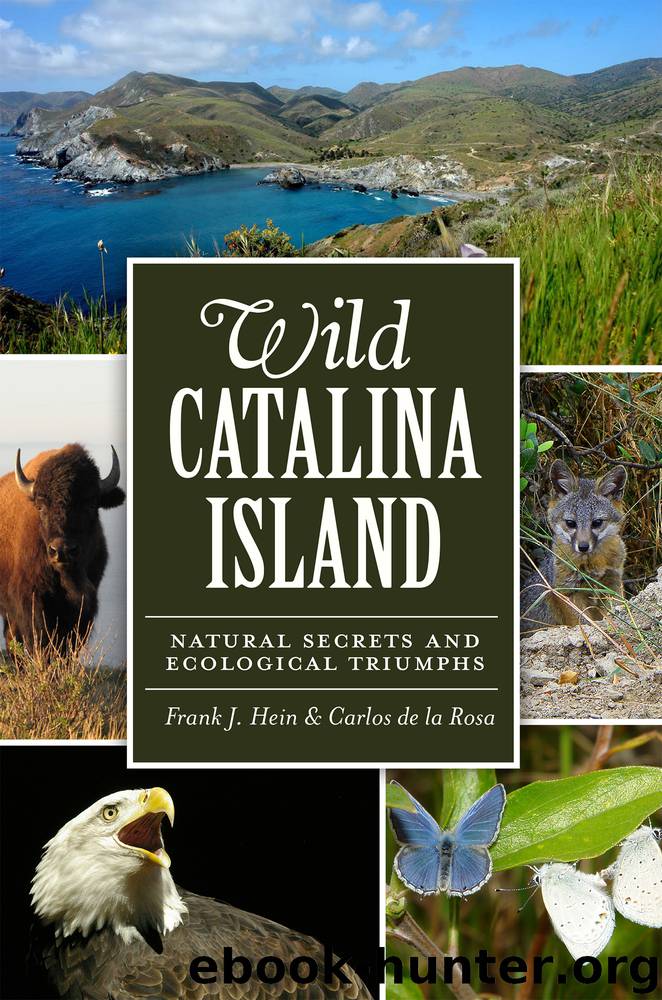Wild Catalina Island by Carlos de la Rosa Frank Hein

Author:Carlos de la Rosa, Frank Hein
Language: eng
Format: epub
Published: 2018-12-12T16:00:00+00:00
When plates collide! This close-up shows the forces that ultimately led to the formation of Catalina and the Channel Islands. Courtesy of Gary Jacobson .
Alone at sea, Catalina emerged as an oceanic island, waiting for life to arrive. Its proximity to Los Angeles County (seen here across the San Pedro Channel is Palos Verdes Peninsula) as well as its ecotourism infrastructure makes it the most visited of all the Channel Islands. Courtesy of Frank Starkey .
Eventually, most of the Farallon Plate split and dove down into the magma, leaving only small remnants grinding away to the north and south. Essentially, as time marched on, the main part of the Farallon slid under North America and out of the way. That massive debris field contained the building blocks from which Catalina and the other Channel Islands would rise. Eventually, sediments from the mainland also washed into the sea and piled up along the edge of the continent where the plates met. It was a beautiful mess.
As the Farallon continued its slide into the mantle, the Pacific Plate was hot on its heels. Without the Farallon Plate to hold it back, the Pacific Plate could now move more or less freely until it too slammed into North America. When this new contact occurred, things got really interesting. The Pacific Plate sat higher than the Farallon and didn’t subduct under the North American Plate. Instead, the two plates pressed on each other, creaked and buckled until eventually something had to give. In time, the Pacific Plate began to slide north, taking a lot of the coast (and most of the Continental Borderlands) with it.
Twenty million years ago, before the Pacific Plate started moving north, the coastline was still more or less uniform—but that was about to change. Over the course of just a few million years, Baja and the Sea of Cortez were formed by literally being torn from the mainland by the Pacific Plate as it pulled it north. The entire edge of the continent from Mexico up to and beyond San Francisco started being pulled so hard it too began to shear away from the continent. The seam that runs along the North American Plate is known as the San Andreas Fault. One of the reasons scientists get so excited by the San Andreas Fault is that they know it’s not a matter of if the edge of the continent is going to break more of North America free and shift north but when. It is moving a little bit every year, and sooner or later, it’s really going to let loose. Nobody knows exactly what will happen, but when it does, one thing’s for sure—it won’t be subtle. Whoever said geology was boring didn’t live in California. And if they did, they weren’t paying attention.
Eventually, as pressures along the boundaries changed, the plates began to press upward and the Northern Channel Islands followed by the Southern Channel Islands began to emerge from the sea. It was at this time, a
Download
This site does not store any files on its server. We only index and link to content provided by other sites. Please contact the content providers to delete copyright contents if any and email us, we'll remove relevant links or contents immediately.
The Lonely City by Olivia Laing(4143)
Animal Frequency by Melissa Alvarez(3771)
All Creatures Great and Small by James Herriot(3542)
Walking by Henry David Thoreau(3247)
Exit West by Mohsin Hamid(3212)
Origin Story: A Big History of Everything by David Christian(3154)
COSMOS by Carl Sagan(2968)
How to Read Water: Clues and Patterns from Puddles to the Sea (Natural Navigation) by Tristan Gooley(2895)
Hedgerow by John Wright(2791)
The Inner Life of Animals by Peter Wohlleben(2781)
Origin Story by David Christian(2701)
How to Read Nature by Tristan Gooley(2677)
Project Animal Farm: An Accidental Journey into the Secret World of Farming and the Truth About Our Food by Sonia Faruqi(2675)
How to Do Nothing by Jenny Odell(2659)
Water by Ian Miller(2608)
A Forest Journey by John Perlin(2601)
The Plant Messiah by Carlos Magdalena(2468)
A Wilder Time by William E. Glassley(2374)
Forests: A Very Short Introduction by Jaboury Ghazoul(2348)
